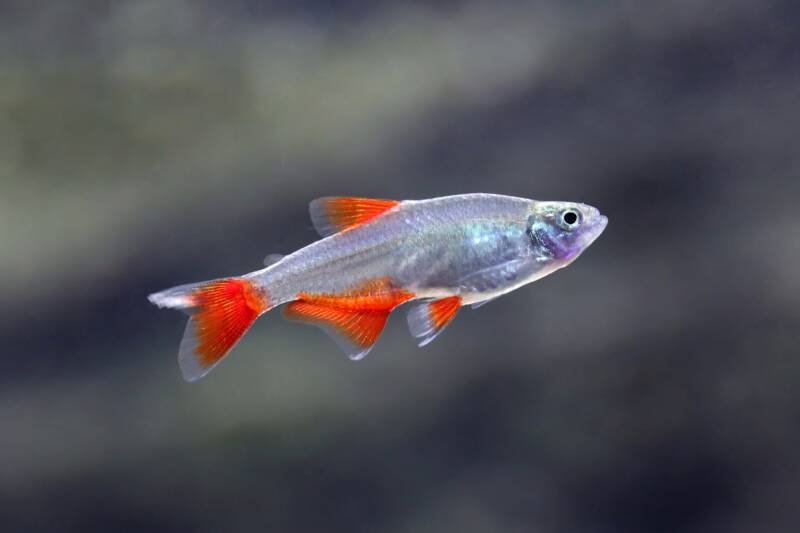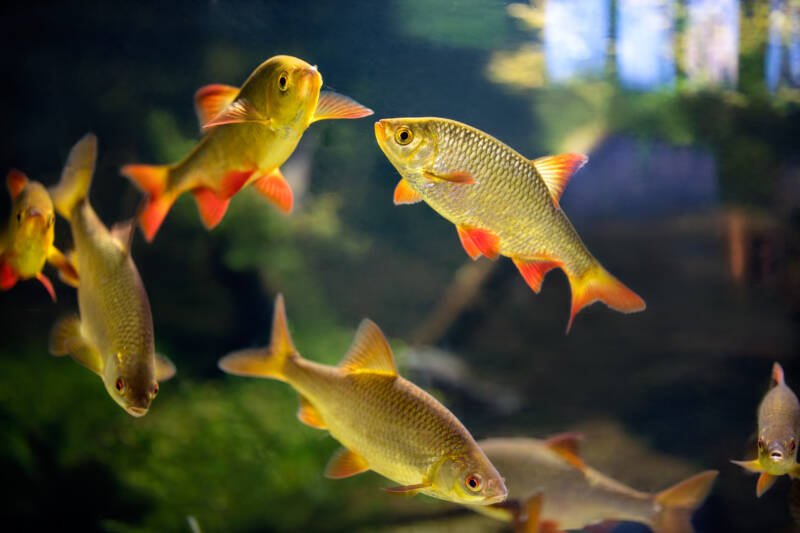The subtle but striking beauty of the bloodfin tetra lends a refreshingly graceful look to any aquarium.
Their appearance is just one of the reasons this fish has become increasingly popular over the years. It’s is a strong contender for both the best schooling fish and the best tetra species.

Like many other freshwater fish in the tetra family, the bloodfin tetra is easy to care for and makes a spectacular addition to community tanks.
In this article
Physical Appearance and Lifespan
Named for their appearance, the bloodfin tetra (Aphyocharax anisitsi) has red fins and a silver body that almost appears transparent. It can also take on a green or blue tinge depending on the aquarium lighting.
They generally grow to roughly 2 inches long, though the females are often larger than the males.
Their lifespan is between five and seven years.
Temperament and Care Level
As a schooling species, this fish is far happier in large groups.
At least six individuals are needed for a school, but they’re happiest with a minimum of one dozen or more.
Bolstered by numbers, they’ll be more adventurous and confident. Though they’ll never be bold, in schools they will feel comfortable interacting with their environment and other types of fish, if present.
The bloodfin tetra is a peaceful fish that gets along well with other docile species. It is not a fin-nipper or territorial towards other fish, making it a good companion.
However, they may occasionally nip the fins of members in their own school. This is normal, but excessive nipping is not and should be addressed.
Though it’s also known as the glass bloodfin because of its delicate appearance, this is a misnomer. This fish is hardy and easy to care for.
It’s one of the best fish for beginner aquarists to keep because of this.
Origin and Natural Habitat
This fish originates in South America, specifically Peru.
It inhabits clear, slow-moving waters with abundant vegetation and warmer temperatures. It can often be found in basins and similar bodies of water.
As a schooling fish, the bloodfin tetra can only be found in large groups in its natural habitat. Because of this, they prefer spaces that have ample hiding and free swimming space.
In such areas, they display amazing schooling behaviors and are the most active and confident.
Tank Setup

Since this is a schooling fish and at least six individuals are necessary, the bloodfin tetra requires a minimum of 30 gallons.
If a larger school is introduced or a community tank is desired, it is recommended to upgrade to at least 50 gallons.
This mid-level swimmer will appreciate lots of tall plants to hide in and explore.
Plants may be live or silk artificial, although bloodfin tetras are more likely to display natural behaviors in setups that closely mimic their natural environment. If live plants are used, the appropriate substrate and lighting will also be necessary.
Since tall plants are recommended, it may be necessary to invest in a more “high-tech” setup beyond the usual 4500K LED lights.
Regular CO2 dosings or a CO2 system will ensure all the aquarium plants thrive, even the high maintenance ones.
Additional elements that will lend a sense of security and safety to this fish is driftwood and rocks, both of which can also be found in their native habitat.
Equipment for Bloodfin Tetras
This species of tetra requires a basic equipment setup, with lighting and CO2 setups as the possible exceptions to this rule.
- Filtration: Since these fish don’t like heavy currents, it’s recommended to use a filter that won’t cause lots of water movement. Undergravel and canister filters may work well for this. However, any filter can be used if the water intake and outtake areas are altered with sponges, nets, etc. to lessen the power of their flow.
- Heating: This fish tends to like warmer waters in the mid to upper seventies, but can also accept temperatures in the high sixties and low seventies. Because of this, a heater is recommended but not strictly necessary. Some aquarists keep bloodfin tetra in cold water aquariums, but it may be harder for them to thrive in this environment.
- Lighting: If you have live plants, you’ll need to invest in a quality lighting system that can support the various plants in your tank, especially the tall ones the tetras like. Automatic lights that come with day cycles and allow you to adjust their RGB levels will work best, although a basic LED setup will also suffice.
- Carbon Dioxide: Similar to lighting, this is the other piece of tank equipment that you may need to spend more money on. CO2 setups can be expensive, but are usually long-lasting and require minimal upkeep. DIY CO2 kits and CO2 liquid dosing kits are also available as more affordable options.
The filter and heater are easy and cost-effective pieces of equipment, but lighting and CO2 setups can be pricier and harder to maintain.
Aquarists should consider their budget carefully to gauge what type of aquarium they can afford to set up and keep.
Aquarium Water Parameters
The water parameters for this fish are straightforward and similar to those of many tetra species. Even so, they are hardy fish that are tolerant of a wide range of temperatures and parameters.
- pH Range: The bloodfin tetra likes a pH between 6.0 – 8.0, either slightly acidic or slightly basic.
- Temperatures: The aquarium can be kept anywhere from 70 – 80 degrees Fahrenheit and these fish will be happy.
- dGH: The water hardness should be kept between 50 to 150 ppm.
Ammonia, nitrites, and nitrates should all be kept as close to 0 ppm as possible since even low levels can have serious health effects.
Though the bloodfin tetra is hardy and can survive even in levels are high as 5 ppm, this is not good for them. Regular water changes and aquarium maintenance is a must for all fish, regardless of how resilient the fish may be.
Food and Diet
Like many fish, the bloodfin tetras are omnivores with a strong preference for live and meat foods. Plant and vegetable foods are healthy for them to eat, but they aren’t specifically partial to these types of foods.
Instead, some of their favorite meals consist of:
- Brine shrimp
- Bloodworms
- Tubifex worms
- Silk worms
- Daphnia
They’ll accept either live, freeze-dried, or frozen meat foods. Flakes and pellet food will also be accepted with enthusiasm, but cannot provide all nutrients these fish need in their diet.
Because of this, flake and pellet foods should only be supplemental. Meat foods should make up the primary portion of the bloodfin tetra’s diet.
Their active lifestyle means that this fish will need to be fed at least once per day. Feed them no more than the amount they can eat in three minutes.
Stop feeding them if you notice their stomachs are extremely distended or bloated.
Adding Bloodfin Tetras to Your Tank
Other fish may be bolder in appearance and behavior, which are certainly desirable traits. But none of these fish come close to surpassing the discreet beauty of the bloodfin tetra.
The modest size, easy temperament, and care of this fish further elevate it.
It is a favorite amongst beginner aquarists and experienced keepers alike and makes a statement in species-only tanks and community environments!